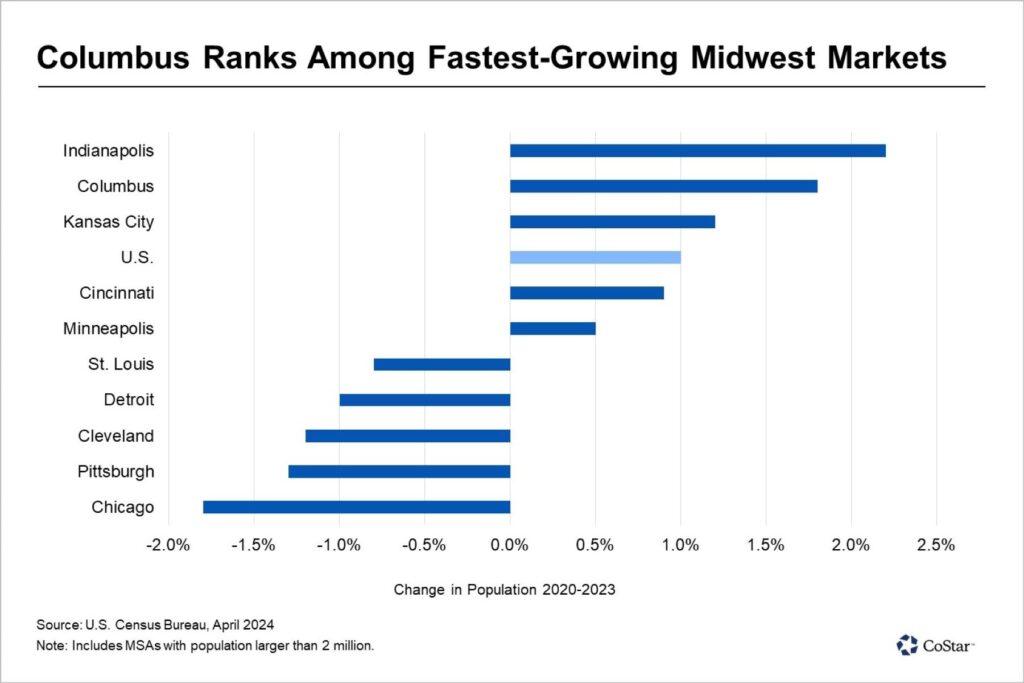New Columbus Population Growth Explode Past National Average
Columbus Emerges as a Leading Growth Market
After years of being associated with the “Rust Belt” decline, Columbus, Ohio, is experiencing a population boom that surpasses the national average. A strong job market and relative affordability are driving sustained migration to the region, making Columbus one of the fastest-growing metro areas in the Midwest, second only to Indianapolis, according to CoStar and the U.S. Census Bureau.

The Columbus Metropolitan Statistical Area (MSA) added 18,200 new residents in 2023, translating to an increase of 0.8%, compared to the national growth rate of 0.5%. Since 2020, Columbus has gained 38,000 new residents, placing it among the top 15 fastest-growing U.S. metro areas with at least 2 million residents. Behind only Indianapolis in the Midwest region.
What’s Driving Columbus’s Population Boom?
The surge in Midwestern metro areas like Columbus can be attributed to several key factors:
- Economic Diversification: Columbus has built a resilient job market with a mix of industries that shield it from economic downturns.
- Manufacturing Resurgence: The return of domestic production and EV gigafactories is creating high-wage jobs that fuel population growth.
- Affordability: The city’s lower cost of living compared to coastal metros makes it attractive for families, young professionals, and retirees.
- Improved Quality of Life: Columbus offers excellent schools, recreation, and a growing cultural scene, enhancing its work-life balance appeal.
The New Midwest Industrial Landscape – EVs and Microchips
The old Rust Belt image is rapidly fading as the Midwest undergoes an industrial transformation driven by advanced manufacturing and technology investments. Columbus, along with other regional hubs, is at the center of this shift.
Key Drivers of the Midwest’s Industrial Revival:
- Re-shoring of Manufacturing Jobs: Companies are establishing EV gigafactories in Columbus, Kansas City, and Indianapolis, bringing production back to the U.S.
- Microchip Manufacturing Expansion: The demand for semiconductors has led to the creation of microchip fabrication facilities, fostering long-term economic stability.
- Growing Skilled Workforce: These industries require specialized labor, creating high-paying jobs that attract and retain talent.
- Real Estate Demand: Economic growth is translating into increased demand for housing and commercial spaces, fueling population growth and rental demand.
Columbus’s Job Market Strengthens Housing Demand
The Columbus labor market remains robust, further supporting population gains:
- Columbus’s unemployment rate stood at 3.8% in February 2024, the lowest among Ohio’s major markets and well below the statewide 4.4% rate.
- Apartment inventory in Columbus has grown 35% over the past decade, outpacing the national growth rate of 28%.
- New housing supply has tempered rent growth, keeping Columbus an affordable alternative to pricier metro areas like Cincinnati.
Large-Scale Investments Fueling Future Growth
Accordingly, Ohio State University is a consistent driver of apartment demand in Columbus. However, recent major corporate investments are expected to drive further job creation and housing demand in Columbus and the broader Midwest:
Intel’s Multi-Billion Dollar Expansion
- Intel is building two wafer fabrication plants in Columbus, which are expected to create 3,000 new jobs.
- Though the project has faced delays, it remains on track for completion in 2026.
Honda’s EV Battery Plant in Jeffersonville
- Honda and LG Energy Services are investing $4 billion to create an EV battery manufacturing hub in Ohio.
- The Jeffersonville plant will generate over 2,000 new jobs, covering the equivalent of 78 football fields in space.
- Honda is also retooling its Marysville and East Liberty assembly plants, contributing to the Midwest’s EV manufacturing boom.
Columbus’s Growth is Reshaping the Midwest
With its tight labor market, affordability, and influx of advanced manufacturing investment, Columbus is poised for continued population growth and housing demand. Alongside Dayton, Indianapolis, and other rising Midwest cities, Columbus stands to benefit from the next wave of industrial expansion.
For investors and developers, this trend signals long-term real estate opportunities, particularly as the city’s housing demand continues to rise. The Midwest renaissance is well underway, and Columbus is leading the charge.
